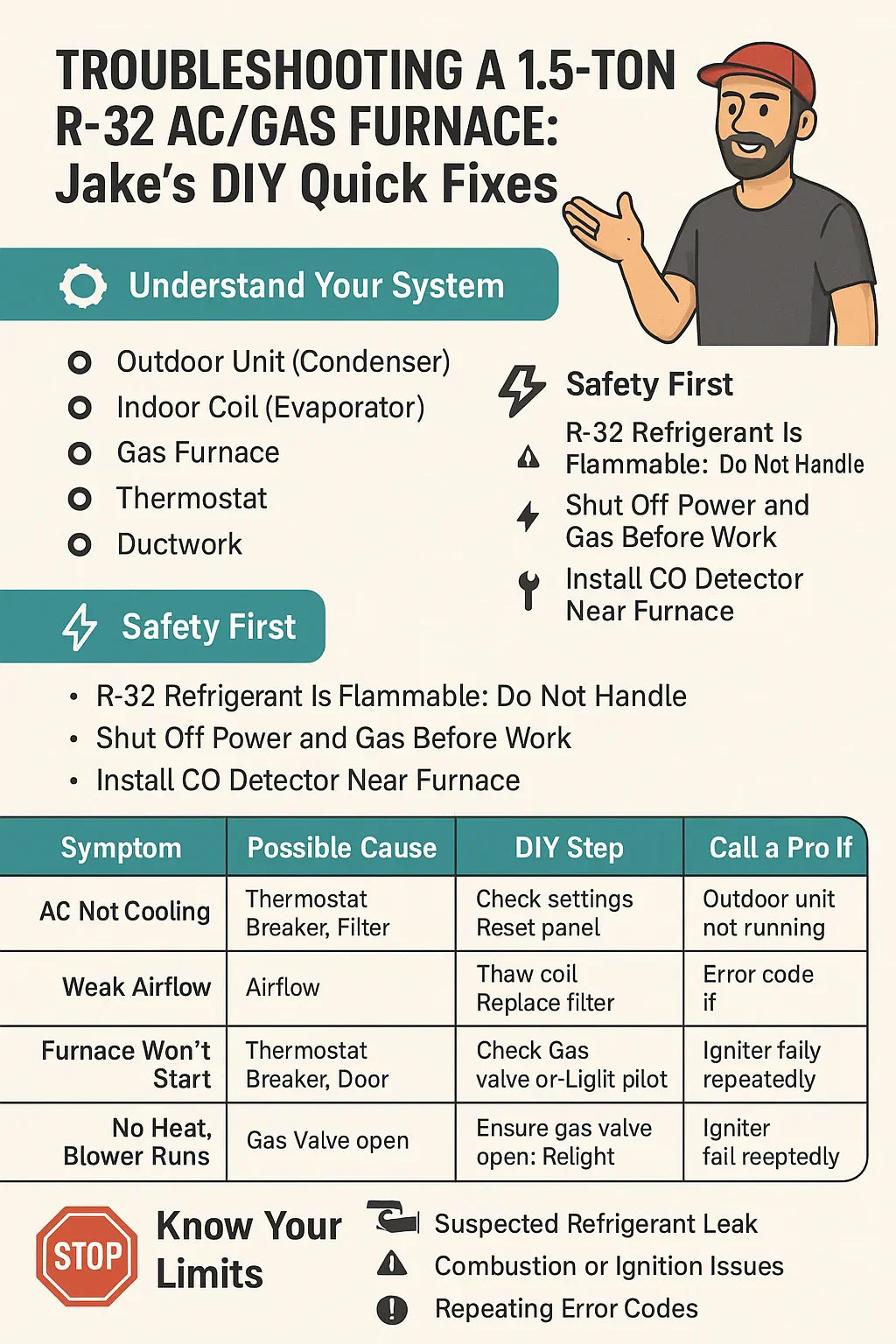🏠 Jake’s Philosophy on DIY HVAC
I’m a big believer in rolling up your sleeves — if you know what you’re getting into.
Over the years, I’ve handled plenty of basic HVAC issues myself: dirty filters, tripped breakers, clogged condensate lines. It saves money, teaches you about your home, and helps you spot problems before they get big.
Best 1.5 Ton AC and Gas Furnaces
But here’s my rule:
If it involves refrigerant, combustion tuning, or major wiring — call a pro.
Why? Because:
-
R-32 refrigerant is an A2L — mildly flammable, requires EPA certification to handle.
-
Gas furnaces involve combustion safety and carbon monoxide risk.
-
Messing up a control board or high-voltage connection can cost more than the repair would have.
My goal here is to give you a clear, safe roadmap for troubleshooting — knowing when to keep going and when to stop.
🔍 Understanding Your R-32 AC/Gas Furnace System
A 1.5-ton R-32 AC with a gas furnace is actually two systems sharing one air handler (the furnace’s blower).
Main components you’ll see:
-
Outdoor unit (condenser): Houses the compressor, fan, and condenser coil (R-32 refrigerant lives here)
-
Indoor coil (evaporator): Sits above the furnace; cools air in summer
-
Gas furnace: Burner section, heat exchanger, blower
-
Thermostat: Your control point
-
Ductwork: Delivers conditioned air throughout the house
Rule: You can look at all of this. You can clean certain parts. You cannot legally open the refrigerant circuit unless you’re certified.
⚡ Safety First: A2L Refrigerant & Gas Safety
R-32 Refrigerant
-
Classified as A2L — low toxicity, mildly flammable
-
Only trained techs should handle
-
Never cut or disconnect refrigerant lines
Gas Furnace Safety
-
Shut off gas at the service valve before working
-
Install and test CO detectors annually
-
Never block intake or exhaust vents
📎 Energy.gov — Furnace Safety Tips
Lockout/Tagout Basics
-
Turn off the breaker for the furnace/AC
-
Verify with a non-contact voltage tester
-
Shut off gas if working in burner area
🛠 Common AC Issues & DIY Fixes
1. AC Not Cooling
Possible Causes:
-
Thermostat not set to COOL
-
Tripped breaker
-
Dirty air filter
-
Dirty outdoor coil
Jake’s Quick Fix:
-
Set thermostat to COOL, temp below room temp.
-
Check breaker panel — reset if tripped.
-
Replace or clean filter.
-
Turn off power, gently rinse outdoor coil with hose (avoid high pressure).
2. Weak Airflow
Possible Causes:
-
Dirty filter (again!)
-
Blocked supply/return vents
-
Blower wheel dust buildup
DIY Step:
-
Filter and vent check — easy.
-
Blower cleaning: Shut off power, remove blower access panel, vacuum dust with soft brush.
3. Frozen Coil
Possible Causes:
-
Low airflow (dirty filter, blocked return)
-
Refrigerant leak or restriction (call a pro)
DIY Step:
-
Turn off AC, run fan only for a few hours to thaw.
-
Replace filter and check vents.
-
If it happens again, stop — could be refrigerant issue.
🔥 Common Furnace Issues & DIY Fixes
1. Furnace Won’t Start
Possible Causes:
-
Thermostat not set to HEAT
-
Tripped breaker
-
Furnace door switch open
DIY Step:
-
Set thermostat to HEAT, temp above room temp.
-
Check breaker and reset.
-
Reseat furnace door — many have a safety switch.
2. Blower Runs, No Heat
Possible Causes:
-
Gas supply off
-
Pilot light out (older models)
-
Igniter failure (call a pro)
DIY Step:
-
Verify gas valve is ON.
-
If older standing pilot, relight per manufacturer’s instructions.
📎 Goodman Furnace Troubleshooting
3. Short Cycling
Possible Causes:
-
Dirty filter
-
Blocked vent or flue
-
Thermostat in bad location (near heat source)
DIY Step:
-
Clean/replace filter, check outdoor vent termination for obstructions.
💧 Condensate & Drain Problems
Symptoms
-
Water around furnace
-
AC stops cooling, trips float switch
DIY Fix:
-
Shut off power.
-
Remove drain line, flush with white vinegar or warm water.
-
Use wet/dry vac at outside drain termination to clear blockage.
📎 Trane Condensate Maintenance
📡 Thermostat & Control Board Tips
Thermostat
-
Check batteries (if applicable)
-
Verify mode and schedule
-
Reset to factory defaults if erratic
Control Board
-
Many flash error codes — check your manual
-
Some codes indicate simple fixes (filter, switch open)
📋 Jake’s Quick-Check Troubleshooting Chart
| Symptom | Possible Cause | DIY Step | Call a Pro If |
|---|---|---|---|
| AC not cooling | Thermostat, breaker, filter | Reset, replace filter | Outdoor unit not running |
| Weak airflow | Filter, vents blocked | Replace filter, open vents | Still weak after cleaning blower |
| Frozen coil | Low airflow | Thaw, replace filter | Coil keeps freezing |
| Furnace won’t start | Thermostat, breaker, door | Reset/check | Error code persists |
| No heat, blower runs | Gas off, pilot out | Turn on gas, relight | Igniter fails repeatedly |
| Water leak | Clogged drain | Flush drain | Leak continues |
🚫 Know Your Limits
STOP and call a pro if:
-
You suspect a refrigerant leak
-
You smell gas or see a cracked heat exchanger
-
You get repeated error codes after resets
-
You need to open the sealed refrigerant system
📎 EPA Section 608 Certification Rules
✅ Final Thoughts from Jake
A 1.5-ton R-32 AC and gas furnace combo is generally low-maintenance — most issues you’ll run into are airflow- or control-related, and those are often DIY-fixable in minutes.
That said, always respect the lines: refrigerant and combustion tuning are pro-only jobs. Keep up with filters, coil cleaning, and drain maintenance, and your system should run smooth for years.
In the next topic we will know more about: Is a 1.5‑Ton R‑32 AC and Gas Furnace Enough for Your Home? Jake’s Sizing Guide







